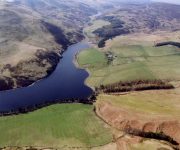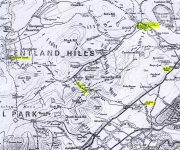Harkness is one of the oldest of Scottish surnames, its origin almost – but not quite – lost in the mists of time. The story of the name begins more than 700 years ago at a time when surnames were only beginning to be used in Scotland; a time when we have little in the way of written history or records.
In medieval Scotland at the beginning of August the Lammas Fair was held. Lammas survives to this day in a week long annual fair held in the town of St. Andrews and in the quarter days of the Scottish Courts of Law.
It was an important date in the calendar when the first wheat of the year was harvested and rents were paid. Markets, fairs and gatherings took place all over Scotland; cattle, sheep and produce were bought and sold; the first bread was baked with the year’s new wheat. It was a time when betrothals of marriage were made, debts settled, business dealt with and courts were held.
A 13th century parchment document records that on the Friday next after the Feast of Saint Peter ad Vincula – Lammas the first Friday in August – 1280, a judicial enquiry was held) at St. Katherine’s Chapel in the Pentland hills some four miles south west of Edinburgh.
Thomas de Hardkneys was one of the jurors. The ‘de Hardkneys’ or ‘of Hardkneys’ tells us that he came from a place called ‘Hardkneys’. Farmers who were tenants were described as ‘of’ while those who owned their farms, very few in those days, were described as ‘in’.
The enquiry was held to resolve a dispute between local farmers about paying ‘punlayn’ – an ancient fine imposed for allowing animals to stray onto neighbouring land. Some of the farmers were tenants of ‘The Lord of Brad’ and others were tenants of the king, at that time Alexander III. A cleric recorded the proceedings on a parchment document that survives in the National Archives of Scotland (RH5/231). The document lists the names of the jurors attending the enquiry, mostly local farmers or land stewards. Thomas de Hardkneys was a farmer living in the area and may well have been one of those attending who could speak to the facts “for fifty years ‘byefaud’ and more”.
It is common in early Scottish writing to find the double ‘ss’ at the end of a name written as ‘ys’ ‘is’ or even ‘fs’. After 700 years, many of the names recorded in the document still exist, as place names, in and around the Pentland Hills. It is interesting to note changes in the spelling of the names in the document and their present forms:-
| Name in Document | Existing Name in the Pentland Hills Area |
| Bavelay | Bavelaw – castle and farm |
| Balhernoc | Balerno – village and suburb of Edinburgh |
| Bounayelin | Bonally – village |
| Harlau | Harlaw – farm and reservoir |
| Bradwod | Braidwood – farm |
| Cotis | Coates – farm |
| Walstun | Walstone – farm |
| Maleny | Malleny – farm |
| Botland | Buteland – farm |
| Listunschelis | Listonshiels – farm |
Given the variations and changes in spelling, together with other facts that will be covered later, it is difficult not to conclude that Hardkneys and Harkness are the same name.
The farm Harkness or Hardkness no longer exists by that name. Research to establish its location was carried out and is summarised at the Archaeology page.


